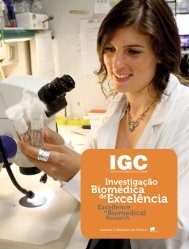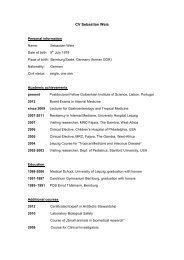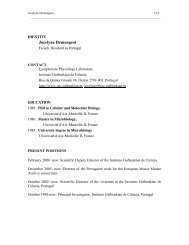organisation - the Instituto Gulbenkian de Ciência
organisation - the Instituto Gulbenkian de Ciência
organisation - the Instituto Gulbenkian de Ciência
- No tags were found...
Create successful ePaper yourself
Turn your PDF publications into a flip-book with our unique Google optimized e-Paper software.
HOXA10 AND THE EVOLUTION OF THE VERTEBRATE BODY PLAN<br />
One of <strong>the</strong> functions of Hox genes of <strong>the</strong> paralogue group 10 during patterning<br />
of <strong>the</strong> axial skeleton is to block rib formation. This function is essential for <strong>the</strong><br />
formation of <strong>the</strong> rib-less areas of <strong>the</strong> vertebral column caudal to <strong>the</strong> ribcage,<br />
such as <strong>the</strong> lumbar vertebrae. It has been shown that in snakes Hoxa10 is expressed<br />
within <strong>the</strong> rib-forming area, suggesting that in snakes this gene has lost<br />
<strong>the</strong> ability to block rib formation. Whe<strong>the</strong>r this is an intrinsic property of <strong>the</strong><br />
protein itself or due to alterations in <strong>the</strong> networks downstream to this gene,<br />
remains to be <strong>de</strong>termined. In this project we aim at un<strong>de</strong>rstanding this problem.<br />
We found that <strong>the</strong> snake Hoxa10 blocks rib formation when assayed in mouse<br />
embryos. Therefore, <strong>the</strong> absence of activity in <strong>the</strong> snake is not due to intrinsic<br />
properties of <strong>the</strong> protein. We i<strong>de</strong>ntified a polymorphism in <strong>the</strong> Hox-responsive<br />
enhancer of Myf5 that ren<strong>de</strong>rs <strong>the</strong> enhancer unable to bind Hox proteins. When<br />
assayed in transgenic mice using a BAC reporter approach, we saw that this<br />
polymorphism is functionally relevant, which explains <strong>the</strong> inability of Hoxa10 to<br />
block rib formation in snakes.<br />
IGC ANNUAL REPORT ‘11<br />
RESEARCH GROUPS<br />
50






